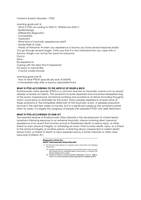Contents
Lecture 1 Chapter 9: The eye (7 pages) .................................................................................................. 2
Lecture 2 Chapter 10 The central visual system (8 pages) ..................................................................... 9
Lecture 3 A look into the brain Chapter 7 (6 pages) ............................................................................. 17
Lecture 4 Chapter 8 The chemical senses (6 pages) ............................................................................. 23
Lecture 5 Chapter 3,4,5,6 membrane potentials / action potentials / signal transduction via synapses
/ neurotransmitters and receptor systems (5 pages) ........................................................................... 29
Lecture 6 Chapter 15 Chemical control of the brain and behavior (8 pages) ....................................... 34
Lecture 7 Chapter 12 Touch and pain (6 pages) ................................................................................... 42
Lecture 8 Chapter 14 Motor cortex and Cerebellum (6 pages) ............................................................ 48
Lecture 9 Chapter 16 motivation (from an evolutionary perspective) to maintain the internal milieu
constant (8 pages)................................................................................................................................. 54
Lecture 10 Chapter 14 Organisation of directed (voluntary) movement, movement disorders (4
pages) .................................................................................................................................................... 62
Lecture 11 Chapter 20 Language (8 pages)........................................................................................... 66
Lecture 12 Chapter 21 (3 pages) ........................................................................................................... 74
1
,Lecture 1 Chapter 9: The eye (7 pages)
Characteristics of visible light
Only electromagnetic radiation with wavelengths of 400-700 nm
is visible to the naked human eye. Within this visible spectrum,
different wave lengths appear as different colors
➢ Color is a perception of the brain…
Light in a thicker medium will be refracted in the direction of a
line perpendicular to the surface
Pupil: opening for light to pass through
Sclera: the ‘white’ (at least in humans)
Iris: controls amount of lightening
Optic nerve: axons coming from the retina
Lens: bends light, allows focusing
Ciliary muscle: changes lens shape
Vitreous humor: clear liquid
Retina: photoreceptors
Fovea: center of visual field (macula around it)
Optic disk: exit point for optic nerve/blood vessels (blind spot) > no photoreceptors here
Farsighted: you are able to see objects far away, but not near
you. This is vice versa for people who are near-sighted
Pupillary constriction:
• By light-reflex, consensual, brainstem: 1 eye in the light, both pupils will constrict.
The pupil that did not directly get the light in the eye is called a ‘consensual’ eye
• To deepen the depth of the field (aperture of camera)
Visual field:
• To be determined with object-angle
Visual acuity (sharpness of image):
• Limited by distance between photoreceptor cells: e.g. when
looking at a star, coupled photoreceptor cells next to the
fovea make the star visible (so looking next to the star)
Ganglion cells are the only ones providing output of retina
Light-sensitive cells in retina are photoreceptor cells
If for example an animal has reflecting capacity of the retina, it has better night vision (like a
cat)
2
,Horizontal and amacrine cells: communication within the retina
Cone photoreceptor:
• 3 types pigment: blue, red and green, so three types of
opsins!!
➢ Miss one of these opsins: won’t see that colour (2 of
them are X-chromosome linked (bad for men))
• Active under ‘photopic’ conditions (active in bright light)
• Concentrated in central retina (fovea)
Rod photoreceptor:
• 20 times more than cones (in human retina)
• 1x type pigment
• 1000x more sensitive than cones! (less light needed to
activate them)
• Active under ‘scotopic’ conditions (active in low light)
• Concentrated in peripheral retina
Retina is a ‘duplex’: both under light and dark conditions
The only place to directly reach the photoreceptor cells is via the fovea. It
contains more cones than rods
Central: high resolution. Photoreceptor (mostly cones) are connected to a
single bipolar cell
Peripheral: low resolution, but easier to observe something. Multiple bipolar
cells connected to single ganglion cell
Other cells absorb some of the light
when light passes through
Phototransduction in rods
Under ‘resting’ conditions
• Neurons: Emem= -65 mV
• Rods: Emem= -30 mV
• Depolarization in rods caused by influx of
Na+
• ‘dark current’
• Photo receptors hyperpolarize by light
Light > G-protein coupled receptor > conformational change on a molecule called retinal >
hyperpolarization (decrease in Na+ conductance) > no initiation of action potential
Photoreceptors are continuously depolarized in the dark because of an inward sodium
current, the dark current.
(a) sodium enters the photoreceptor through a cGMP-gated channel
3
, (b) light leads to the activation of an enzyme that
destroys cGMP, thereby shutting off the Na current and hyperpolarizing
the cell
Rhodopsin consists of:
• Opsin: 7 transmembrane a-helices
• Retinal: conformation changes by light, bleaches rhodopsin
And activates transducin (GPCR)
(a) In the dark, cGMP gates a
sodium channel, causing an
inward Na+ current and
depolarization of the cell.
(b) The activation of rhodopsin by
light energy causes the G-
protein (transducin) to
exchange GDP for GTP, which
in turn activates the enzyme
phosphodiesterase (PDE).
PDE breaks down cGMP and shuts off the dark current
Because of the constant stream inward of sodium, the cell in the dark is less negative
than in the light and thus goes from depolarized to hyperpolarized when going from
dark to light. So in the dark: release of glutamate via vesicles and in the light no release
Structure of cGMP
The intracellular messenger of phototransduction is 5’-cyclic guanosine
monophosphate (cGMP). Upon illumination the activated phosphodiesterase (PDE)
hydrolizes cGMP to GMP by cleaving the cyclic phosphate bond
➢ Signal amplification of 1 photon is possible!
Light (rod-to-cone) adaptation
• 5-10 minutes complete saturation (hyperpolarisation of rods
and cones)
• Pupil constriction
• Ca2+ influx ends. Calcium normally is a blocker for the
conversion of GMP to cGMP. With this, the brake on
guanylyl cyclase is removed and cGMP levels increase
rapidly, which rapidly causes cGMP-gated channels to go
open
Dark (cone-to-rod) adaptation
• Duration 20-25 minutes
• Lightsensation 106x
• ‘unbleaching’ of rhodopsin
• Adaptation of functional neuronal circuitry
4










